|
Queen’s Chamber
As mentioned before, if you continue at the junction of the
ascending passage and Grand Gallery through the horizontal passage,
which runs for 127 feet, you wind up in the Queen’s Chamber, which
is directly beneath the apex of the pyramid. This passage is 3 feet
9 inches high and 3 feet 5 inches wide. A sudden drop of 2 feet
occurs towards the end of the passage before the entrance to the Queen’s Chamber.

The drop or step in the horizontal passage
leading to the Queen’s
Chamber
The Queen’s Chamber has a rough floor and a gabled limestone roof.
The name Queen’s Chamber is a misnomer. The custom among
Arab’s was to place their women in tombs with gabled ceilings (as
opposed to flat ones for men), so this room came to be labeled by
the Arab’s as the Queen’s Chamber.
The chamber dimensions are 18
feet 10 inches by 17 feet 2 inches. It has a double pitched ceiling
20 1/2 feet at its highest point, formed by huge blocks of limestone
at a slope of about 30 degrees. When this chamber was first entered,
the walls were encrusted with salt up to 1/2 inch thick. This has
been removed since then, most likely when the chamber was cleaned.
Salt encrustation was also found on the walls of the subterranean
chamber. The cause is unknown.

The Queen’s chamber showing the Niche in the east wall
and high
gabled roof to the left
There is a report by an Arab, Edrisi, who died around 1166 AD. He
entered the pyramid through the forced entrance made by Al mamoun and describes not only an empty granite box in the king’s
chamber, but also a similar one in the queen’s chamber.
It was uninscribed and undecorated just like the one in the king’s chamber.
What ever happened to this granite box in the queen’s chamber if it
ever existed remains a mystery.

The Niche in the
Queen’s Chamber
Colonel Vyse also dug up the floor in the Queen’s chamber but only
found an old basket so they refilled the holes. What ever happened
to this basket remains a mystery. The Niche was originally about 3 ½
feet deep. Throughout the years, explorers have hacked it deeper and
it currently is about several yards deep. The Niche is just over 16
feet high.
We have seen that the airshafts from the King’s Chamber were found
to exit to the outside of the pyramid. It appears that the Queen’s
Chamber airshafts do not lead to the outside but may terminate
within the pyramid. The discovery of these airshafts in the Queen’s
Chamber is an interesting story. John and Waynman Dixon, in 1872
thought there may be similar shafts in the Queen’s chamber. A crack
was observed in the south wall of the Queens Chamber in a spot where
they suspected an airshaft might be located. They inserted a wire
into this crack and it went through a certain distance. After
chiseling for about 5 inches through the masonry, they broke into
the southern airshaft.
They noticed this airshaft was about 9 inches
square. It went vertically for about 6 feet and than went upward and
disappeared from their sight. They also found the airshaft in the
northern wall by chiseling through the northern wall in the same
location of where they found the air shaft in the Southern wall.
They tried to locate the exit points of these shafts but could not
find any. They even lit a fire in the shafts and the smoke did not
billow back or exit to the outside. Why were these shafts sealed off
with 5 inches of masonry at their ends? Where do they lead?
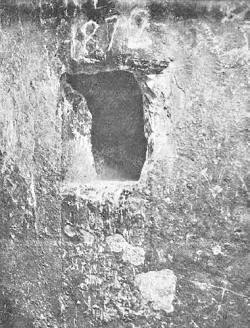
North airshaft of the Queen’s Chamber
Rudolf Gantenbrink in 1993 sent a small robot with a camera up the
southern airshaft in the Queen’s Chamber. After traveling about 200
feet up the airshaft it came to a small door complete with copper
handles. The airshafts are about 9 inches square. In September of
this year, both airshafts were explored using a robot and this
continued search for hidden chambers will be explored in Chapter 5.
Now, we will go back and continue down the descending passage way.
It’s dimensions are the same as the ascending passage, 3 1/2 feet
wide by almost 4 feet high, and slopes down at an angle of about 26
degrees.
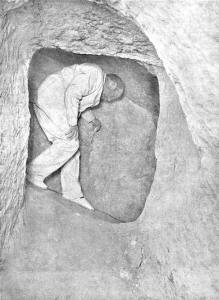
Cramped posture necessary in the Descending Passageway
as viewed
from the lower end of the well shaft
The distance of the descending passage to the beginning of the
horizontal subterranean chamber passage is about 344 feet. This
shorter horizontal section leads to a small lesser subterranean
chamber and then continues into the large subterranean chamber.
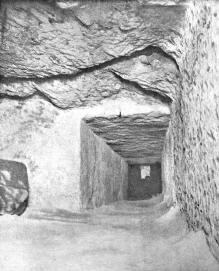
Lesser Subterranean Chamber
and Subterranean Chamber Passage
This large chamber is a strange place, measuring 46 X 27 feet with
height of about 11 feet. It is cut deep into the bedrock almost 600
feet directly below the apex of the Pyramid. Its ceiling is smooth
and the floor is cut in several rough levels, making it look
unfinished. It has also been referred to as the “upside down room”.
When the Arabs first broke in to the pyramid in 820 A.D., they found
torch marks on the ceiling showing that someone had entered the
pyramid before them and explored these lower chambers. If anything
was here, it was removed.
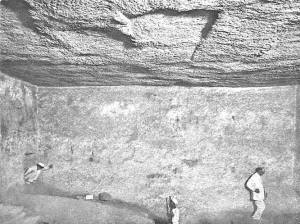
Subterranean Chamber showing east wall and ceiling

Subterranean chamber looking north
showing the entrance doorway from
the horizontal passage and pit
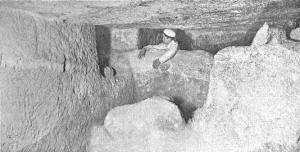
Subterranean Chamber showing the Pit
In the center of this chamber on the east side is a square pit,
which is known as the “bottomless pit”. It is called the “bottomless
pit” since at the time of its discovery; it was not known how deep
it was.

Subterranean chamber
looking north showing the entrance doorway
from the horizontal
passage and pit
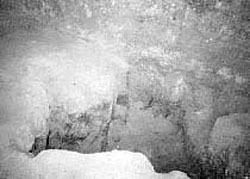
Subterranean Chamber
showing the Pit
This Pit in 1838 was measured to be 12 feet deep.
Colonel Vyse,
searching for hidden chambers, had it dug deeper.
The Edgar brother’s account of their visit to the pyramid in 1909
state that,
“In the unfinished floor of the subterranean chamber
appears the large, squarish mouth of a deep vertical shaft. We had
always to avoid walking too near its edge, for the rough uneven
floor of the chamber is covered with loose crumbling debris”.
In the south wall, opposite the entrance, is a low passage (about 2
1/2 feet square), which runs 53 feet before coming to a blind end.
When John and Edgar Morton explored this passage in the early
1900’s, they stated that the floor of this passage was covered with
dark earthy mould, two to three inches deep.
At the intersection where the ascending passage meets with the Grand
Gallery is a hole, which leads to a shaft (known as the well shaft),
which connects, with the descending passage below. This near
vertical tunnel is about 3 feet in diameter. As it continues
downward a grotto opens off the shaft. The shaft than continues
downward to connect with the lower part of the descending passage.
The purpose of this well shaft remains a mystery.

The lower end of the well shaft
as viewed from the opposite wall of
the descending passage
The earliest investigator to give any really scientific data of the
Great Pyramid was the Oxford astronomer John Greaves. He visited
Egypt in 1637 in order to explore thoroughly its pyramids, and in
particular the Great Pyramid. He made a new discovery that others
had missed. At the beginning of the Grand Gallery towards one side,
a stone block had been removed and a passage appeared to have been
dug straight down into the depths of the pyramid. He had discovered
the entrance to the so-called “Well Shaft”.
The opening was a little
over 3 feet wide and notches were carved opposite one another on the
sides of this shaft so someone could climb down with support.
Greaves lowered himself down to about 60 feet, where he found that
the shaft was enlarged into a small chamber or grotto. The shaft
continued below him but it was so dark and the air was foul that he
decided to climb back up. The purpose of this Well Shaft puzzled
him.
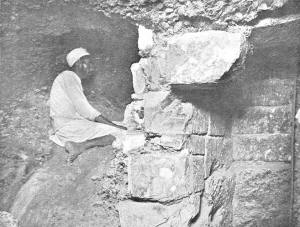
The Grotto looking north
He published his investigations under the title,
Pyramidographia: A
Description of the Pyramids in Egypt (1646). This was the first book
ever published just on the Great Pyramid. His work gave a great
stimulus to other investigators, and English, French, German, Dutch,
and Italian explorers soon followed him.
One of the most interesting aspects of archeology is the search for
hidden chambers in ancient structures. We will look at the
historical search for hidden chambers and passageways in the
Great
Pyramid, and you will learn of artifacts that have been found in it.
Hidden Chambers
The possibility of discovering hidden chambers or passages in the
pyramid has interested man for thousands of years. The thought of
finding hidden treasures, the blueprints of the pyramid, lost
scientific information and technological devices of a lost culture
have motivated man to search for a hidden chamber within the pyramid
and in other ancient structures. Before this century, the only way
of conducting this type of exploration was to bore into the
structure, hoping by luck you would hit an undiscovered passage or
chamber. This was done when the Arabs first tried to find an
entrance into the pyramid as described in Chapter 1. Other explorers
have similarly left their mark on the structure with nothing of
significance discovered. Now we have modern scientific instruments
to help us continue the search.
Experiments in the past have been conducted using sophisticated
equipment, which records measurements of magnetic fields, sound
waves, and other fields to try to discover hidden chambers within
these structures. The use of cosmic ray probes, developed by Dr.
Louis Alvarez, who won the Noble Prize for physics, was utilized by
him in 1968 to try to find hidden chambers in Kephren’s pyramid (2nd
largest pyramid).
Dr. Alvarez, along with Dr. Ahmed Fahkry, an
antiquities expert carried out the experiment. Cosmic rays
continually bombard our planet and they lose some of their energy as
they penetrate rocks. If there are hollow spaces in the rock, the
rays loose less energy than if the rock was solid. A spark chamber
could measure the energy of these rays and record the information on
tape.
The spark chamber was placed in a chamber (46 X 20 X 16 feet) in the
base of the pyramid. It appeared that something strange was going
on. The oscilloscopes showed a chaotic pattern and each time the
data was run through the computer, different results came out. No
one knew why this was happening. So, the results were inconclusive
and unfortunately they failed to find any hidden chambers and it
also raised doubts as to the efficacy of their methods. They did not
continue their work to explore the other pyramids or structures.
Others have tried to follow up on their research and methods to
discover hidden chambers.
In 1974 a team from Stanford University and the Ains Shams
University of Egypt, attempted to find hidden chambers using an
electromagnetic sounder. It used radio wave propagation to find
hidden chambers. Unfortunately, because of certain environmental
problems (for example moisture in the pyramid), this method did not
conclusively work either. This method for finding hidden chambers
was abandoned for the time being.
In 1986, two French architects used electronic detectors inside the
Great Pyramid to try to locate hollow areas. They found that below
the passageway leading to the Queen’s Chamber was another chamber 3
meters wide by 5 meters. They bore a 1” hole and found a cavity
filled with crystalline silica (sand). They were not allowed to do
any further digging. No entrances to these areas have yet been
found. This sand was analyzed and found to contain more than 99%
quartz that varied in size between 100-400 microns. This kind of
sand is known as musical sand since it makes a sound like a
whispering noise when it is blown or walked on. It appears that this
sand may come from El Tur in southern Sinai, which is several
hundred miles from the Great Pyramid. Why would this type of sand be
brought in from such a large distance and placed in a sealed off
chamber in the Great Pyramid?
In 1987, Japanese researchers from Waseda University used x-rays to
look for hollow spaces and chambers. They claimed to have discovered
a labyrinth of corridors and chambers inside the Great Pyramid. They
found a cavity about 1-½ meters under the horizontal passage to the
Queen’s Chamber and extending for almost 3.0 meters. They also
identified a cavity behind the western part of the northern wall of
the Queen’s Chamber. Other investigators have been unable to confirm
this but hopefully more scientific studies will be permitted to try
to verify these results.
In 1988 another Japanese team identified a cavity off the Queen’s
Chamber passageway, which was near to where the French team drilled
in 1986. A large cavity was also detected behind the Northwest wall
of the Queen’s Chamber. The Egyptian government stopped the project
and no further investigations were done.
In 1992, ground penetrating radar and microgravimetric measurements
were made in the Pit in the subterranean chamber and in the
horizontal passage connecting the bottom of the descending passage
with the subterranean chamber. A structure was detected under the
floor of the horizontal passage. Another structure was detected on
the western side of the passageway about 6 meters from the entrance
to the subterranean chamber. Soundings studies seem to indicate it
is a vertical shaft about 1.4 meters square and at 5 meters deep.
It is interesting to speculate about these chambers. What was their
purpose and do they still contain anything? It is hopeful that more
studies will be permitted in the near future.
Exploring the Air Shafts in the Queen’s Chamber
Up to 1872, no airshafts were discovered or suspected to exist in
the Queen’s Chamber. In that year, an engineer, Waynman Dixon
decided to look for airshafts in the Queen’s chamber. He reasoned
that if there were airshafts in the King’s chamber, why not in the
Queen’s Chamber as well. While looking at a section of the southern
wall where he thought an airshaft most likely would be located, he
noticed a crack. Using a hammer and chisel he quickly broke into an
airshaft measuring about 9 inches square going straight back into
the wall about 7 feet and then rising at an angle and disappearing
in the dark. Thus he discovered the southern airshaft into the
queen’s chamber.
Why was this airshaft never finished? It ended several inches inside
the wall of the Queen’s Chamber. He then went to the opposite side
or northern wall of the Queen’s chamber and did the same with a
hammer and chisel and found the other airshaft. It also went in
about 7 feet and then started to rise at an angle. Why these shafts
were not cut through into the chamber remains a mystery.
As earlier stated, we have known since the 1800’s that the airshafts
from the King’s chamber exit to the outside of the pyramid and the
actual exit points have been located. The airshafts in the Queen’s
Chamber are a different story. Where they terminate is not known. No
exit points on the surface of the pyramid have yet been found and it
has been assumed that these shafts end inside the pyramid. Many have
speculated that they end in a secret or hidden chamber.
In the last decade we have developed the technology, which allows us
to explore this small shaft, measuring about 9 inches square. In
1993, Rudolf Gantenbrink from Germany used a miniature robot with a
camera to explore the southern airshafts leading out of the Queen’s
chamber. This robot was a very sophisticated device and its
manufacturing cost was about a quarter of a million dollars. It fits
into the opening of the airshaft and controlled by a cable attached
to it.
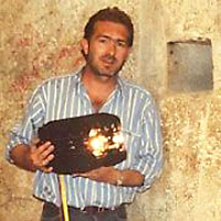 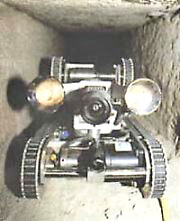 
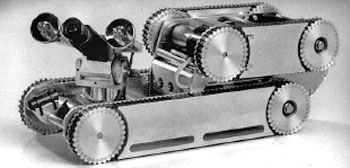
Rudolf Gantenbrink
and Upuaut
2
Thus, Gantenbrink and his staff positioned the small robot in the
small airshaft of the southern end of the Queen’s chamber and moved
it very slowly up the airshaft. A camera was mounted on the robot
and they could monitor its progress as it moved upwards. As the
robot proceeded up the airshaft, it sent back some of the first
pictures of what the inside of the airshaft looked like. It finally
came to the end of its journey after traveling about 200 feet into
the shaft.
The shaft did not lead to the outside but they saw at the
end of the shaft a small door with two small copper handles. It
appeared that there was a little gap under the door. There was not
enough room for the robot to go under or for the camera to see under
the door. Thus, another mystery had appeared. What if anything is
behind this door at the end of the airshaft?
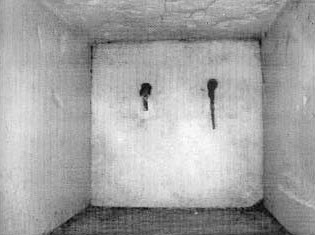
Door with metal handles filmed by Upuaut at the end of the southern
shaft
Gantenbrink had plans to pursue the exploration of the shaft but
unfortunately, possibly because of the politics, the Egyptian
authorities did not allow him to continue. His robot, Upuaut is
currently in the British Museum and nothing further came of his
exploration until many years later.
In 1995, Zahi Hawass, Director of the Giza Plateau in Egypt,
announced that there would be a follow up on the exploration of the
door leading to the alleged hidden chamber sometime in May of 1996.
He stated that an Egyptian, Dr Farouk El-Baz and a Canadian team
would conduct the exploration. This exploration never happened. Dr.
Hawass appeared on The Art Bell Show in January of 1998. He stated
that he hoped to explore the shaft and what was behind the door by
May of 1998. Again, nothing happened.
In late 1998, talks again surfaced of another group of researchers
who were developing a new and better robot to explore the airshafts.
In fact one of the rumors was that the new robot was designed and
would be operated by NASA scientists in late 1998 or1999. Nothing
further was ever heard of this rumor and no statements were made. It
was also rumored that during the millennium celebration in Egypt at
the Giza plateau, that the door at the end of the shaft would be
opened. This also never happened.
The big day finally came on
September 16, 2002 when millions all
over the world watched on TV. An exploration with a new robot was
approved by the Egyptian authorities and sent up the Southern
airshaft on this day. It was also mounted with a camera, a measuring
device, and a high-powered drill. This robot was special designed by
“iRobot” of Boston.
 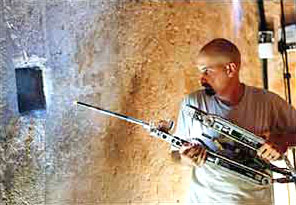
Pyramid Rover
by “iRobot” of
Boston
The measuring apparatus was used to try to
determine how thick the door was and to determine if a drill would
penetrate it so the camera could look inside. The measuring
apparatus found that the block was only 3 inches thick, suggesting
that it might be a door leading to another chamber.
The robot
drilled a small hole in the wall. When the camera looked through, it
appeared that there was a small empty chamber and another stone door
blocking the way. This next door appeared to be sealed and they did
not drill through this door. Millions viewed this event and many
were disappointed that they did not continue the exploration either
in that shaft or the other shaft.
Unknown to the general public, several days later, they sent the
robot up to explore the northern shaft. They discovered another door
blocking this shaft identical to the one in the southern shaft. The
doors in both shafts are 208 feet from the queen’s chamber. Up until
them, no one knew if the northern shaft extended to the north as far
as the southern shaft goes to the south. This newly discovered
northern shaft door appears to be similar to the door in the
southern shaft. It also has a pair of copper handles like the
southern door. No further exploration was done at that time.
Artifacts Found in the Great Pyramid
Since the1800’s several very interesting items have been found in
the Great Pyramid of Giza. In 1836, the explorer Colonel Vyse
discovered and removed a flat iron plate about 12” by 4” and 1/8”
thick from a joint in the masonry at the point where the southern
airshaft from the King’s chamber exits to the outside of the
pyramid. Engineers agree that this plate was left in the joint
during the building of the pyramid and could not have been inserted
afterwards. Colonel Vyse sent the plate to the British Museum. The
famous Sir Flinders Petrie examined the plate in 1881. He felt it
was genuine and stated “no reasonable doubt can therefore exist
about its being a really genuine piece”.
The following are the documents that were sent to the British Museum
to verify and certify the find.
The Iron plate, which Mr. Hill discovered in 1837 in an inner joint,
near the mouth of the southern air channel was sent to the British
Museum, with the following certificates:
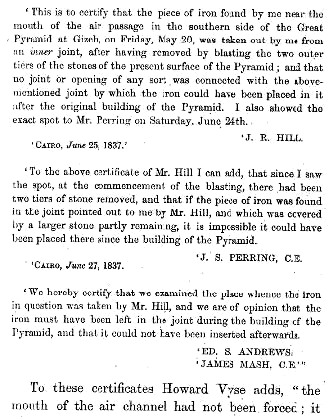
measured 8 7/8 inches wide, by 9 ½ inches high.”
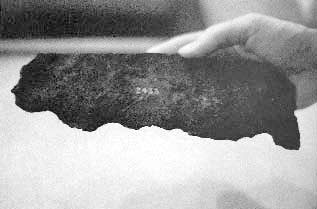
Fragment of the Iron Plate that was extracted from the core masonry
near the exit point of the southern shaft of the King’s Chamber in
1837
In 1989 Dr. Jones analyzed it in the mineral resources engineering
department at Imperial College and Dr. El Gayer in the department of
petroleum and mining at the Suez University. They used both chemical
and optical tests. One hypothesis was that the metal might have come
from a meteorite. It has been well documented that primitive and
Stone Age peoples have often used meteorite iron for implements,
such as tools and ritual objects. They were able to make crude iron
implements from the meteorite iron well before the Iron Age. In
fact, wrapped in King Tut’s mummy was a dagger made of meteorite
iron.
We can determine if this metal is meteorite or from the earth
by the nickel content of the Iron. Meteorite “iron” has a higher
value than the iron found on earth. The analysis of the metal plate
showed that it was not of meteoritic origin, since it contains only
a trace of nickel and not at the higher level of meteoritic iron.
Further analysis revealed that it had traces of gold on its surface,
indicating it maybe have once been gold plated. In their written
analysis, Drs. Jones and Gayer concluded the following:
“It is concluded, on the basis of the present investigation, that
the iron plate is very ancient. Furthermore, the metallurgical
evidence supports the archeological evidence, which suggests that
the plate was incorporated within the pyramid at the time that
structure was being built.”
As we mentioned, the finding of this iron plate may cause us to
change the date of the Iron Age by more than 2000 years. Drs. Jones
and Gayer thought this plate might be a fragment from a larger
piece, which was fitted over the mouth of the airshaft. Up to now,
this larger piece, of which the plate was a part, has not been
found.
Artifacts Found in the Queen’s chamber Airshafts
Waynman Dixon, the engineer who discovered the openings of the
Queen’s Chamber airshafts in 1872, also discovered some very
interesting objects in the northern Queen’s chamber airshaft. A
little ways up the airshaft, he found these three objects:
These objects were brought to England with
Dixon when he returned.
However, in a short period of time they had disappeared. Recently it
was found that they had remained in the hands of the Dixon family
and in the 1970’s were donated to the British Museum. They remained
there unknown until the 1990’s when they reappeared again. It is
interesting to note that the wood artifact was missing. This wood
could have been C14 dated and maybe given us the year of the
building of the Great Pyramid of Giza.
As mentioned above, in 1993 Rudolf Gantenbrink explored the southern
airshaft with his robot. He also sent the robot up the Northern
airshaft for a short distance beyond where Dixon found his
artifacts.
The robot discovered (on video film) two artifacts:
-
A metallic hook
-
A long piece of wood
Maybe this wood could be removed and Carbon14 dated.
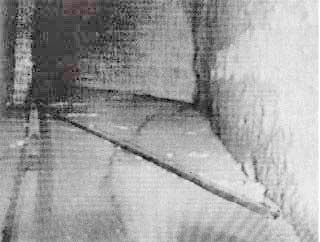
Northern Shaft of the Queen’s Chamber showing the wood
Hopefully, we will not have to wait too long to continue the
exploration of the shafts in the Queen’s Chamber. What lies behind
the second door in the southern airshaft, and also the first door in
the northern airshaft, remains a mystery for now. It would also be
very important to remove some of the artifacts still remaining in
the Northern Air shaft for testing. Maybe a newer robot would have
the capabilities to remove these objects and even a sample of the
copper handles on the door. It appears from the photographs that
some of the copper has broken off and is on the ground by the door.
Maybe this can be retrieved and analyzed as well.
Many scientists are trying to develop other means of discovering
hidden chambers and passages in the Great Pyramid of Giza and other
monuments and structures. It is an exciting possibility that one
day, maybe a hidden chamber will be found and reveal to us
information about our past that we were not aware of. Also, we will
wait to see what is behind all those sealed doors in the Queen’s
Chamber airshafts.
|






















